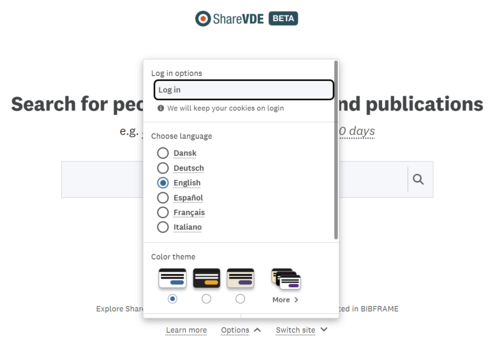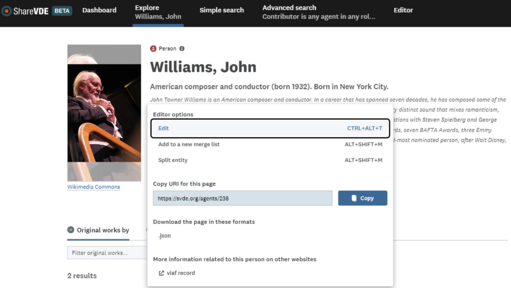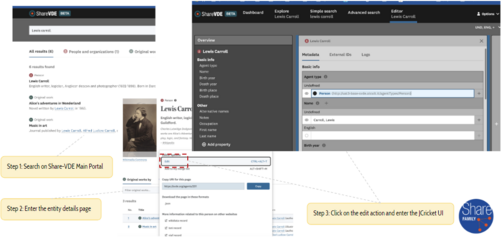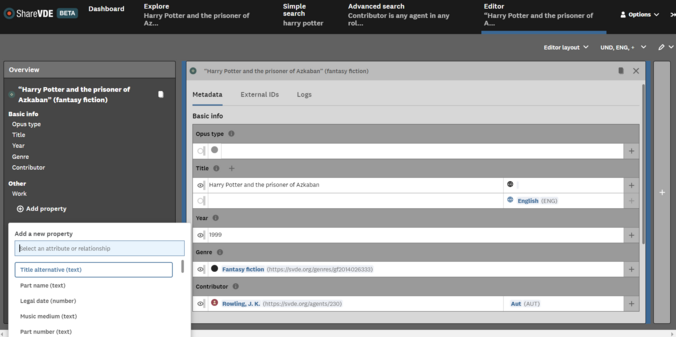mNo edit summary |
mNo edit summary |
||
| Line 18: | Line 18: | ||
Also, not only JCricket operates on members' institutions data processed by the the LOD Platform, but it can serve as a bridge with cross-domain contexts to create links with third parties, such as FOLIO community and Wikidata. | Also, not only JCricket operates on members' institutions data processed by the the LOD Platform, but it can serve as a bridge with cross-domain contexts to create links with third parties, such as FOLIO community and Wikidata. | ||
=== JCricket | === JCricket overview === | ||
Here follows the high-level description of JCricket functions. All manual functions are also available through corresponding GraphQL APIs. | Here follows the high-level description of JCricket functions. All manual functions are also available through corresponding GraphQL APIs. | ||
| Line 25: | Line 25: | ||
The system fetches MARC records – or records in other formats - from the institution for ingestion and BIBFRAME conversion; linked data entities are created from this process and stored in the Cluster Knowledge Base (CKB). In this context, JCricket serves as a transformative tool, enabling librarians with specific authorization levels to refine and enhance the quality of the data. By facilitating human intervention, it acknowledges the inherent limitations of automated processes and harnesses the expertise of librarians to elevate the accuracy and richness of the shared knowledge base. | The system fetches MARC records – or records in other formats - from the institution for ingestion and BIBFRAME conversion; linked data entities are created from this process and stored in the Cluster Knowledge Base (CKB). In this context, JCricket serves as a transformative tool, enabling librarians with specific authorization levels to refine and enhance the quality of the data. By facilitating human intervention, it acknowledges the inherent limitations of automated processes and harnesses the expertise of librarians to elevate the accuracy and richness of the shared knowledge base. | ||
[[File:EntityEditor 1714466922976.png|none|thumb|493x493px|JCricket is integrated in the discovery portal web interface, for authenticated users.]] | [[File:EntityEditor 1714466922976.png|none|thumb|493x493px|JCricket is integrated in the discovery portal web interface, for authenticated users.]] | ||
Within the knowledge base, each cataloger can work on the dataset, using the Provenance to identify their own data. Through the dedicated JCricket web interface, librarians can engage in a spectrum of operations. Key operations include the ability to edit, update, create, delete properties or invalidate clusters. | Within the knowledge base, each cataloger can work on the dataset, using the Provenance to identify their own data. Through the dedicated JCricket web interface, librarians can engage in a spectrum of operations. Key operations include the ability to edit, update, create, delete properties or invalidate clusters. | ||
| Line 31: | Line 30: | ||
[[File:EntityEditor interface.png|none|thumb|503x503px|JCricket user interface.]] | [[File:EntityEditor interface.png|none|thumb|503x503px|JCricket user interface.]] | ||
The JCricket user interface allows librarians to merge multiple clusters into one, addressing cases where different clusters should logically belong to the same entity but were produced as different clusters in automated processes. Conversely, librarians can split a cluster into multiple clusters to rectify cluster reconciliation discrepancies. These edits on entities are saved in the system. Any operation performed on the entity is reported on the Logs page, to have a clear idea of the status of the entity/cluster. | |||
[[File:EntityEditor edit.png|none|thumb|676x676px|Entity editing on the JCricket interface.]] | |||
__FORCETOC__ | __FORCETOC__ | ||
Revision as of 09:11, 30 April 2024
Appunto di Anna: capire qual è il nome definitivo di jcricket e riportare qui contenuto di:
- spiegare il concetto di prisma da qualche slide
- mettere riferimento a jcricket ux guide di filip e a manuale d'uso per bibliotecari
The LOD Platform technology enables institutions to embrace the advantages of linked open data. The Cluster Knowledge Base (CKB, or Entity Knowledge Base) is the result of the entity identification and resolution obtained through clustering processes with data coming from different participating libraries with enrichment of external sources. JCricket is the Linked Data Entity Editor developed by the Share-VDE community, a tool designed for collaboratively curating entity data living in the CKB.
The entity editor JCricket opens new forms of cooperation among institutions. The CKB is conceived as a live source of authoritative data: through JCricket editor, member institutions engage in collaborative entity management and in a new way of performing authority control. JCricket is the tool for collaborative linked data entity management. It enables - according to the BIBFRAME ontology - the entity curation (e.g. creation of new entities, entity modification, the application of entity merge and split functions). The scope is to improve the quality of the Entity Knowledge Base that is a live source produced through clustering and daily update processes. JCricket is a manual application that makes it possible to manage bibliography data in the form of entities. It empowers professional librarians to enhance the quality of machine-generated data output of MARC to BIBFRAME transformation.
Also, not only JCricket operates on members' institutions data processed by the the LOD Platform, but it can serve as a bridge with cross-domain contexts to create links with third parties, such as FOLIO community and Wikidata.
JCricket overview
Here follows the high-level description of JCricket functions. All manual functions are also available through corresponding GraphQL APIs.
For more detailed descriptions of the manual functions, refer to the user manual.
The system fetches MARC records – or records in other formats - from the institution for ingestion and BIBFRAME conversion; linked data entities are created from this process and stored in the Cluster Knowledge Base (CKB). In this context, JCricket serves as a transformative tool, enabling librarians with specific authorization levels to refine and enhance the quality of the data. By facilitating human intervention, it acknowledges the inherent limitations of automated processes and harnesses the expertise of librarians to elevate the accuracy and richness of the shared knowledge base.
Within the knowledge base, each cataloger can work on the dataset, using the Provenance to identify their own data. Through the dedicated JCricket web interface, librarians can engage in a spectrum of operations. Key operations include the ability to edit, update, create, delete properties or invalidate clusters.
The JCricket user interface allows librarians to merge multiple clusters into one, addressing cases where different clusters should logically belong to the same entity but were produced as different clusters in automated processes. Conversely, librarians can split a cluster into multiple clusters to rectify cluster reconciliation discrepancies. These edits on entities are saved in the system. Any operation performed on the entity is reported on the Logs page, to have a clear idea of the status of the entity/cluster.



